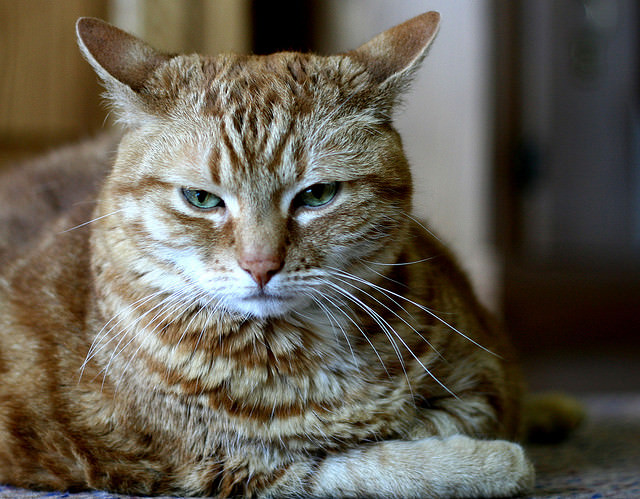Almost everything your cat does– even the behavior problem that drives you crazy– is for a very specific purpose. The complicated part is trying to figure out the purpose of the behavior problem. Understanding what your cat is trying to communicate to you is the key to solving the issue. To make things more complicated, some of her behaviors may actually stem from medical issues rather than environmental issues.
A trip to the veterinarian may be in order if your cat is exhibiting any of these common behavior problems to rule out or diagnose an underlying health issue.

Image Source: Douglas O’Brien via Flickr.com
#1 – Over-grooming
Most cats are meticulous groomers (it’s one of their best features!), but over-grooming often happens because a cat is very stressed or anxious. Cats like routine and predictability and will resort to an act like grooming to self-soothe and create a bit of dependability in their otherwise unstable environment (a move to a new home, a new baby, the death of a favorite family member, etc.). The grooming can quickly turn into a compulsive behavior and over-grooming can lead to the loss of fur, irritated skin, and even open wounds.

Image Source: Chris Erwin via Flickr.com
#2 – Under-grooming
Under-grooming can lead to dandruff, itchy skin, and an oily, matted coat. If your cat is neglecting her regular grooming habits it could be a sign of an underlying health issue, depression, or she may have achey or stiff joints that are preventing her from accessing more hard-to-reach areas.

Image Source: HannaElise via Flickr.com
#3 – Aggression
Aggression can be a sign that your cat isn’t feeling well and that there’s an underlying health issue that needs to be addressed. If she becomes aggressive when you touch a certain part of her body (like her hind leg), it may give you a clue about a tender area. Cats can also become aggressive when they’re feeling stressed out about something in their environment.

Image Source: Tomi Tapio K via Flickr.com
#4 – Litter Box Avoidance
Litter box problems are some of the most common behavior problems, and they are responsible for a significant number of the cats that get surrendered to animal shelters each year. While it may seem like your cat is suddenly peeing on the rug because she’s being “naughty”, she may be doing it because of an infection of her urinary tract, bladder, or kidney. This behavior may even continue after an infection gets cleared up because she will have associated the litter box with the pain she was experiencing when she urinated. A cat with joint pain may also avoid the litter box if it’s too far away and too daunting or painful to get to.

Image Source: Dwight Sipler via Flickr.com
#5 – Chewing
If your cat likes to chew on strange or inappropriate items (plastic bags, your new sweater, your left running shoe) it could be a sign that your cat is stressed out. It could also be a sign that she’s experiencing dental pain or discomfort, or that she has an upset stomach.

Image Source: David J Laporte via Flickr.com
#6 – Yowling
Some cats yowl simply because they’re trying to get your attention to let you know the food bowl is empty, but yowling can also be a sign that your cat is in pain or feeling uncomfortable from an underlying health issue. Cats can also yowl when they’re feeling stressed or anxious.

